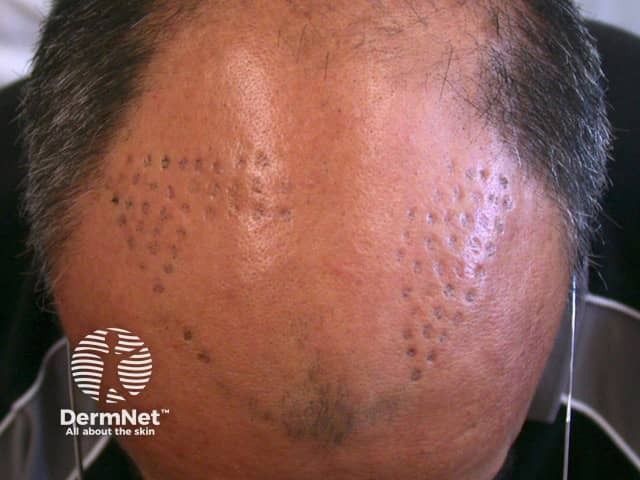Main menu
Common skin conditions

NEWS
Join DermNet PRO
Read more
Quick links
Introduction Patient selection Techniques Transplantation process Complications Other types A cosmetic alternative
Hair replacement surgery is the surgical movement of 'permanent' hair along with its roots to an area of bald or balding skin. There are several surgical techniques available but the method most often used today is hair transplantation.
Hair transplantation is used predominantly to treat the hereditary balding condition known as androgenetic alopecia (male pattern hair loss or less often, female pattern hair loss). Patients with male pattern hair loss tend to have 'lifetime' hair on the sides and back of the head, which are used as donor sites in transplantation.
Hair transplantation does not work on alopecia areata as the transplanted hair will not grow in the area.
Hair transplantation involves removing small pieces of hair and follicles from the donor area (usually hair on the back and sides of the head) and relocating them to the bald or thinning area. The transplantation is a long and complex procedure that involves two distinct processes: donor harvesting and the preparation of recipient sites.
Donor harvesting
It is important to only harvest protected hair follicles to ensure their survival when transplanted. The hair on the back and sides of the head is known as donor dominant or lifetime hair and when moved will continue to grow as it would have in its original site.
There are several different techniques used to harvest hair follicles.
Technique |
Procedure |
|
|---|---|---|
Punch harvesting |
|
|
Excision |
|
|
Strip harvesting |
|
|
Once the donor tissue is harvested, they may be transplanted directly (grafts obtained by punch harvesting) or cut into smaller grafts. The shape and size of the grafts is one of the key factors in the final outcome of hair transplantation. Grafts containing fewer hairs usually provide better results as there is less clumping of hair as it starts to regrow. Graft shapes and sizes include:
Preparation of recipient sites
Several techniques are used to prepare the recipient sites for where grafts are to be placed. Once the sites are prepared small forceps or needles are used to grasp the graft and gently insert it into place.
Technique |
Procedure |
|
|---|---|---|
Single hair and slit grafting |
|
|
Dilation (modified slit grafting) |
|
|
Punch grafting |
|
|
Laser-assisted grafting |
|
|
Hair transplantation is done in a doctor's office and can take between 4 to 8 hours depending on the extent of the transplantation.
Traditionally, hair transplantation has been performed in multiple planned sessions that are spaced 3-6 months apart. A typical session might average between 150 and 300 grafts. However, more recently the trend is to place more grafts per session. It is not uncommon for sessions to involve 750 to 2000 grafts. The purported benefit of these 'mega sessions' is a reduced number of hair transplantation visits to achieve hair restoration in a shorter period of time. The possible downfall is reduced overall graft survival where grafts are packed very close together.
The procedure is usually done under local anaesthetic and does not cause too much discomfort. In most cases, immediately after the hair transplant the hairs fall out of the grafts and do not regrow for 1–3 months. The donor sites gradually heal to leave slight scarring but this is concealed by “lifetime” hair growing around the site. Patients need to be aware that hair transplantation does not produce an instantaneous head of hair but the results are seen over time.
Hair transplantation is a surgical procedure so complications can and do occur as with any other surgical procedure. Possible complications include:
The areas affected by balding are likely to progress.

Hair transplants
The following techniques are still performed although they have largely been replaced by hair transplantation.
These techniques produce a more dramatic and instantaneous result but are becoming less popular because of the following reasons:
Hair loss can be hidden without surgery. Techniques include: